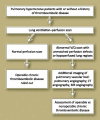Chronic thromboembolic pulmonary hypertension
- PMID: 20376164
- PMCID: PMC2844955
- DOI: 10.1007/s11936-010-0062-0
Chronic thromboembolic pulmonary hypertension
Abstract
The pulmonary hypertension (PH) and right heart dysfunction that results from chronic thromboembolic involvement of the pulmonary vascular bed is potentially curable with surgical endarterectomy. Over the past several decades, growing clinical experience has brought about increased recognition of this treatable form of PH. Moreover, advances in cardiothoracic surgical techniques have given an increasing number of patients with chronic thromboembolic PH (CTEPH) a surgical remedy with decreasing perioperative morbidity and mortality risks. The availability of pulmonary hypertensive-specific medical therapy for CTEPH patients with surgically inaccessible disease also has been a positive therapeutic advance over the past several years. However, despite this progress, chronic thromboembolic disease as a sequela of acute pulmonary emboli continues to be underappreciated. Furthermore, even if CTEPH has been appropriately diagnosed, misinterpretation of diagnostic information may lead to the inappropriate exclusion of patients from surgical consideration. This may result in the prescription of pulmonary hypertensive medical therapy in CTEPH patients with potentially surgically correctable disease. This difficulty arises from a lack of objective criteria as to what constitutes surgical chronic thromboembolic disease, which primarily is a result of the variability in surgical experience in specialty centers in the United States. Consequently, clinicians must be wary about using pulmonary hypertensive medications in CTEPH patients. Before prescription, it is important to exclude patients from surgical consideration by consulting a specialized center with expertise in this discipline.
Figures
Similar articles
-
Update on chronic thromboembolic pulmonary hypertension.Trends Cardiovasc Med. 2017 Jan;27(1):29-37. doi: 10.1016/j.tcm.2016.05.010. Epub 2016 May 25. Trends Cardiovasc Med. 2017. PMID: 27345156 Review.
-
Chronic thromboembolic pulmonary hypertension.Semin Respir Crit Care Med. 2009 Aug;30(4):471-83. doi: 10.1055/s-0029-1233316. Epub 2009 Jul 24. Semin Respir Crit Care Med. 2009. PMID: 19634086 Review.
-
The management pattern and outcomes of chronic thromboembolic pulmonary hypertension: rationale and design for a Chinese real-world study.BMC Pulm Med. 2024 Jun 3;24(1):265. doi: 10.1186/s12890-024-03042-5. BMC Pulm Med. 2024. PMID: 38825688 Free PMC article.
-
Chronic thromboembolic pulmonary hypertension: a distinct disease entity.Eur Respir Rev. 2015 Jun;24(136):246-52. doi: 10.1183/16000617.00001115. Eur Respir Rev. 2015. PMID: 26028636 Free PMC article. Review.
-
Chronic Thromboembolic Pulmonary Hypertension: An Update.Diagnostics (Basel). 2022 Jan 19;12(2):235. doi: 10.3390/diagnostics12020235. Diagnostics (Basel). 2022. PMID: 35204326 Free PMC article. Review.
Cited by
-
Pulmonary endarterectomy in chronic thromboembolic pulmonary hypertension: How can patients be better selected?World J Cardiol. 2013 Mar 26;5(3):18-21. doi: 10.4330/wjc.v5.i3.18. World J Cardiol. 2013. PMID: 23539496 Free PMC article.
-
Meta-Analysis of Real-World Clinical Practice to Assess the Effectiveness of Riociguat in Treating Chronic Thromboembolic Pulmonary Hypertension.J Clin Hypertens (Greenwich). 2025 Feb;27(2):e70015. doi: 10.1111/jch.70015. J Clin Hypertens (Greenwich). 2025. PMID: 39957705 Free PMC article.
-
Chronic Thromboembolic Pulmonary Hypertension: Experience from a Single Center in Mexico.Lung. 2016 Apr;194(2):315-23. doi: 10.1007/s00408-016-9842-y. Epub 2016 Jan 9. Lung. 2016. PMID: 26748498 Free PMC article.
References
References and Recommended Reading
Papers of particular interest, published recently, have been highlighted as: • Of importance, •• Of major importance
-
- Ribeiro A, Lindmarker P, Johnsson H, et al. Pulmonary embolism: one-year follow-up with echocardiography Doppler and five-year survival analysis. Circulation. 1999;99:1325–1330. - PubMed
LinkOut - more resources
Full Text Sources
Miscellaneous


